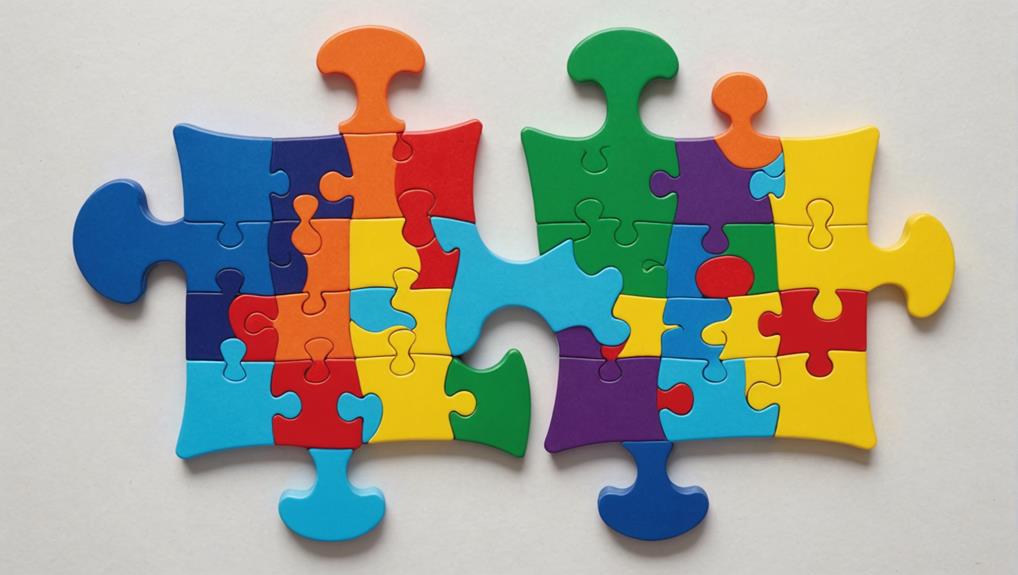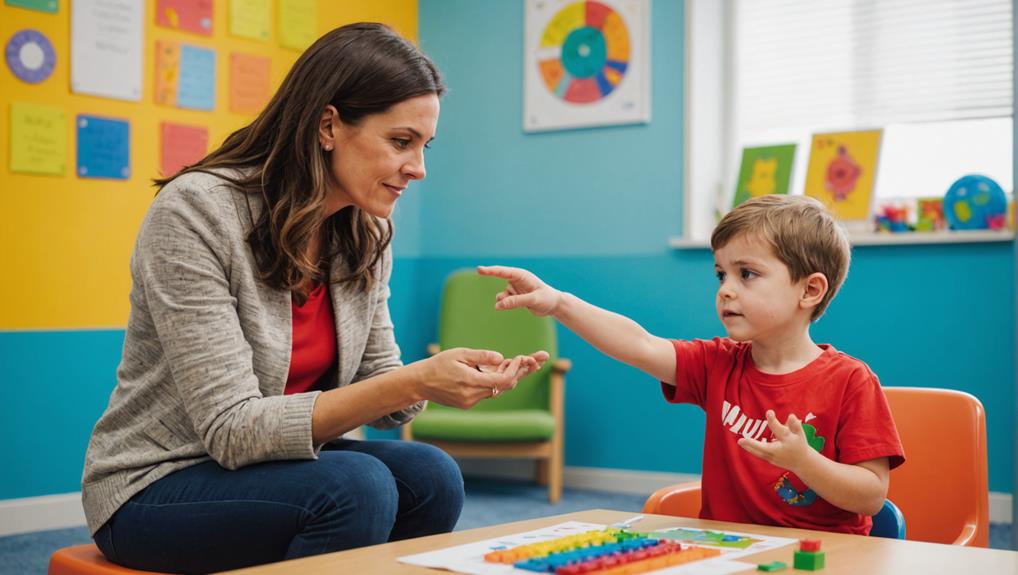The varied and developing world of autism treatment is filled with a range of approaches aimed at improving the lives of individuals on the autism spectrum. These treatments, including Applied Behavior Analysis and occupational therapy, aim to strengthen communication and social interactions while addressing sensory difficulties and behavioral issues. The utmost importance of early intervention in optimizing developmental results cannot be emphasized enough. However, choosing the appropriate therapeutic method is often complex and highly individualized, requiring a more thorough examination of each approach’s strengths.
Key Takeaways
- Autism therapy incorporates approaches like Applied Behavior Analysis, speech and occupational therapy, social skills training, and sensory integration.
- Early intervention in autism therapy can significantly improve social communication, behavior, and adaptive skills.
- Autism therapies are tailored to individuals’ unique needs, considering their behavioral patterns, cognitive development, and sensory processing differences.
- Specialized autism therapies like DIR/Floortime Therapy use engaging activities to foster emotional development and interactive play, which are crucial for social skills.
- Other essential elements of autism therapy include communication skills training, fine motor skill development, structured play-based learning, and behavioral and emotional regulation.
Autism Spectrum Disorder (ASD) Therapy
The therapeutic landscape for Autism Spectrum Disorder (ASD) is expansive, encompassing a wide range of approaches tailored to the distinct needs of each person. These include proven therapy techniques such as Applied Behavior Analysis (ABA), Developmental, Individual-Difference, Relationship-based model (DIR/Floortime), and Cognitive Behavioral Therapy (CBT), which are personalized to address the specific strengths and weaknesses of each child. Early intervention with autism therapy enhances the child’s developmental trajectory and facilitates improved communication, social skills, and adaptive behaviors. We must dive into the variety of these therapeutic approaches and the benefits of early intervention to truly understand the potential of ASD therapy.
Overview of Autism Therapy Approaches
Serving as the cornerstone of therapeutic interventions for Autism Spectrum Disorder (ASD), different methods such as Applied Behavior Analysis (ABA), speech therapy, occupational therapy, and social skills training provide a tailored response to the specific challenges each person faces. Sensory integration is often a crucial part of this therapy, helping individuals with ASD better process and respond to their environment. Considering the early warning signs of autism, such as sensitivity to sounds, treatment might include desensitizing the individual to certain stimuli.
Communication training is another central aspect of autism therapy, encompassing spoken and non-spoken interaction forms. Therapists employ diverse techniques to improve fine motor skills, essential for daily living activities. Recognizing the challenges that individuals with autism may face in initiating and maintaining conversations, techniques such as role-play or video modeling could be used to enhance these skills. Play-based learning is often included, providing a natural and enjoyable way to foster skill development, emotional regulation, and friendship formation.
Each therapy approach is carefully crafted to address the person’s specific needs, ensuring that the strategies used are effective and engaging. Collaboration between therapists, educators, and caregivers is critical to successfully implementing these methods. Through these extensive and personalized interventions, individuals with ASD can experience significant improvements in their communication, social interaction, sensory processing, and daily living skills.
Benefits of Early Autism Therapy
Acknowledging the variety of therapeutic approaches and their benefits, it becomes apparent that starting these interventions as soon as possible can have profound impacts. Early involvement in autism therapy, in particular, can lead to significant progress in social communication, behavior improvements, and the development of adaptive skills. Notably, initial signs of autism, such as reduced babbling, unusual reactions to sensory experiences, and strict adherence to routines, can assist in timely diagnosis and intervention.
The research underscores the vital role of early involvement, revealing that it can improve long-term outcomes for individuals on the autism spectrum. This early start can spark independence and increase the likelihood of children making meaningful progress in necessary life skills. Furthermore, disruptions in routine, a typical behavior in autistic children, can trigger anxiety, highlighting the importance of early involvement services that provide predictability and order in their lives.
Early involvement services can contribute significantly to enhancing the quality of life for children with autism, helping them reach their full potential. Autism therapy initiated at a young age can be a game-changing force, significantly impacting cognitive development and overall functioning.
In essence, the benefits of early autism therapy are numerous and substantial. By prioritizing early involvement, we can optimize the effectiveness of therapeutic strategies and nurture a more promising trajectory for cognitive and social development in children with autism.
What is Autism in Children?

Autism Spectrum Disorder (ASD) is a complex, multifaceted disorder that can significantly influence a child’s developmental trajectory. To fully comprehend the impact of autism and its effect on children’s growth, it is essential to dispel common misconceptions and explore the factual aspects of the disorder. One key aspect to understand is the occurrence of autistic meltdowns, which are involuntary responses to sensory or intense overload, not manipulative actions. These distress responses can provide insights into the child’s mind, and early intervention can prevent escalation. Through this knowledge, we can better understand the diverse ways in which ASD manifests and influences children’s communication, social interactions, and behavior.
Understanding Autism Spectrum Disorder (ASD)
Understanding Autism Spectrum Disorder (ASD) in children is an essential initial step in providing them with the necessary support and treatment. ASD is a neurodevelopmental condition with symptoms that may include challenges in sensory integration, communication, and social skills, as well as specific repetitive behaviors. These symptoms can vary greatly, from mild to severe, impacting a child’s ability to interact and function effectively in their daily lives.
Early signs of autism can appear between 6 and 18 months of age, making early intervention crucial. Common repetitive behaviors, such as hand-flapping, rocking, or repeating words, are prevalent in autism and can aid individuals with ASD in self-soothing or expressing difficulty. Communication therapy and play-based learning are effective strategies for helping children communicate their needs and learn enjoyably.
Improving fine motor skills can contribute to their independence, while behavioral regulation strategies can help manage challenging behaviors. Integrating these interventions, tailored to each child’s specific needs and abilities, can significantly boost their confidence, resilience, and overall success in life. Keep in mind ASD impacts each child differently. Therefore, comprehending the disorder and its diverse expressions is the key to effectively supporting each child’s journey.
Common Misconceptions About Autism
While there is a growing awareness about Autism Spectrum Disorder (ASD) in children, it is often shrouded in misunderstandings and half-truths. These common misconceptions can hinder a child’s path and the support they receive.
One popular misconception is that autism is a result of inadequate parenting or vaccines. This myth is debunked by scientific evidence, which points towards a combination of genetic and environmental factors. Another misunderstood fact is the belief that all children with autism display the same symptoms and behavior. The truth revealed is that autism is a spectrum disorder, with each child showcasing distinct strengths, challenges, and support needs.
Clarifying misconceptions about the causes and manifestations of autism is essential in fostering understanding and empathy. It’s important to keep in mind that every child with autism is different and that early intervention can significantly enhance their quality of life. Misunderstandings only make the journey to this comprehension more complex.
How Autism Affects Development
Exploring the terrain of childhood development becomes more complex when autism comes into play. Autism, a neurodevelopmental disorder, greatly influences a child’s cognitive development, shaping their ability to learn and process information in exceptional ways. This unique cognitive landscape often presents behavioral challenges, which require personalized strategies for management and growth.
The impact of autism on emotional regulation is another vital aspect to consider. Children with autism often face difficulties in identifying and regulating their emotions, a challenge that necessitates specialized therapeutic approaches.
Social interactions, too, are frequently affected. Understanding social cues, participating in group activities, or building friendships may present significant obstacles for a child on the spectrum, highlighting the importance of early intervention and consistent support.
Sensory processing is another area where autism manifests itself. Sensory sensitivities or differences are common, leading to heightened or diminished responses to sensory stimuli.
Lastly, language development often follows a unique path in children with autism. Verbal and nonverbal communication challenges may emerge, underscoring the need for tailored language therapy. Therefore, comprehending how autism impacts development is fundamental to providing effective, empathetic care.
Signs Your Child Might Have Autism

Recognizing early signs of autism in children can be vital for their development and future success. Potential indicators such as atypical behavioral patterns or delays in communication skills must be monitored. By understanding these signs, parents can take appropriate steps toward seeking professional help and initiating timely intervention strategies.
Early Indicators of Autism in Infants and Toddlers
One may notice that autism can manifest in infants and toddlers through a variety of early indicators. A significant warning sign can be observed in social interactions. Infants or toddlers may show limited eye contact or have little response when their name is called. These indicators often become more noticeable when the child is not interested in playing with peers or engages minimally in social exchanges.
Speech development is another area to monitor. Delayed speech or lack thereof by 16 months can be a red flag. Repetitive movements, such as hand flapping, can also indicate autism. Sensory sensitivities may be present, where a child may react unusually to sensory stimuli, such as lights, sounds, or textures.
Routine preferences are another sign. A child might strongly prefer routine and resist changes in daily activities. Monitoring developmental milestones is essential to identifying early signs of autism. If concerns arise, it’s crucial to seek a professional evaluation. Early detection and intervention are vital in helping autistic children achieve their potential.
Behavioral Patterns to Watch For
Following the early signs of autism mentioned previously, specific behavioral patterns can provide additional insights into whether or not your child might have autism. Repetitive behaviors, such as hand-flapping, rocking, or meticulously lining up toys, can be a clear sign. These behaviors and difficulty in social interactions, like maintaining consistent eye contact or understanding emotions, should prompt you to explore early intervention.
Communication delays, including lack of babbling or limited use of gestures, are also typically indicative of autism. Moreover, some children may experience sensory challenges, such as being overly sensitive to sounds, textures, or lights. If your child shows any of these signs, seeking professional help is advisable.
Another behavior to monitor is an intense focus on specific interests or topics. This, along with resistance to change, is characteristic of autism spectrum disorder.
Autism and Gender Differences

In addressing the complexities of autism therapy, it is crucial to recognize the role of gender in how the condition manifests. Research has illuminated notable differences in symptoms between boys and girls, with girls often better at masking their symptoms, leading to potential underdiagnosis. Understanding these gender-specific nuances can effectively tailor interventions to meet each person’s needs.
How Autism Presents Differently in Boys and Girls
The landscape of autism diagnosis and treatment is remarkably diverse, reflecting the wide range of traits and behaviors that are often gender-specific. Exceptionally, gender differences have resulted in presentation variations, with boys being diagnosed at a higher rate. This may primarily be due to girls exhibiting different symptoms or effectively masking their behaviors, a phenomenon known as social camouflage.
Diagnostic challenges arise because girls often show more social imitation skills and may have fewer repetitive behaviors than boys. Research suggests that this camouflaging may make girls’ symptoms less noticeable in social situations, leading to underdiagnosis or misdiagnosis.
Understanding these differences is essential in formulating effective intervention strategies. Recognizing that girls may present differently allows for tailored support that explicitly addresses their distinct needs and challenges. By focusing on these unique differences, we can provide a more empathetic, knowledgeable, and detailed approach to autism therapy.
DIR/Floortime Therapy

DIR/Floortime Therapy, a key element in Autism Therapy, is an approach that prioritizes children’s unique needs, utilizing their inherent strengths through engaging, playful activities. This therapeutic modality promotes feelings and social growth by fostering attention, engagement, and communication. In the following discussion, we will investigate the critical principles of DIR/Floortime Therapy, considering its impact on parent-child relationships, emotional connection, and the comprehensive development of children with autism.
Critical Principles of DIR/Floortime Therapy
Emphasizing the power of play, DIR/Floortime Therapy emerges as an essential tool that facilitates psychological and social development for children with autism. This child-led approach is a form of play therapy that fosters emotional development, relationship building, and interactive play, all of which are crucial for children on the autism spectrum.
DIR/Floortime Therapy is rooted in the concept that play is fun and a vital medium for children to express themselves, learn about the world, and develop essential social skills. This therapy is guided by the child’s interests and motivations, creating a positive and engaging environment for learning.
Therapy promotes emotional development by encouraging children to express their feelings and emotions freely. It strengthens the child-therapist relationship, making it a safe space for children to explore and improve their social and emotional skills. Interactive play aids in communication expansion, helping children express their needs, desires, and thoughts more effectively.
With the active involvement of parents and therapists, DIR/Floortime Therapy ensures a comprehensive, compassionate, and practical approach to autism therapy. It empowers children with autism to thrive, fostering their independence and resilience.
Sensory Integration for Autism

Sensory Integration for Autism is a central aspect of Autism Therapy. It aims to improve how autistic people process and respond to different sensory inputs. This therapeutic approach includes activities stimulating a range of senses and enhancing sensory processing and regulation to foster better engagement in daily tasks. In the context of autism, understanding sensory processing and its impact on behavior is vital to devising effective, personalized therapeutic strategies.
Understanding Sensory Processing in Autism
Understanding sensory processing is a crucial aspect of autism therapy. People with autism often face sensory challenges that impact their daily tasks and social interactions. Sensory integration therapy, which focuses on improving how these individuals process and respond to sensory input, can tackle these challenges.
Sensory integration therapy incorporates various sensory activities designed to stimulate different senses. These activities can involve anything from touching different textures to participating in movement-based activities, providing diverse sensory stimulation. The goal is to boost sensory processing and regulation, helping autistic people respond more effectively to sensory stimuli in their environment.
Communication Skills Training

Communication Skills Training is crucial to Autism Therapy, particularly for nonverbal children. This training equips them with the tools to express their thoughts, needs, and emotions, enhancing their ability to interact with the world around them. Techniques are customized to each child’s needs, ensuring they gain confidence and improve their overall quality of life.
Teaching Communication Skills to Nonverbal Children
In autism therapy, one primary focus is Teaching Communication Skills to Nonverbal Children, a critical form of Communication Skills Training. This training involves techniques such as Picture Exchange Communication System (PECS) training, sign language, and Augmentative and Alternative Communication (AAC) devices. These methods enable nonverbal children, giving them alternative communication methods to express their thoughts, emotions, and needs effectively.
Early intervention with these methods has been shown to improve significantly these children’s social interactions and overall quality of life. Speech therapy, another critical aspect of this training, works on developing verbal cues and sounds, even if full speech isn’t achievable. Conversely, occupational therapy focuses on improving motor skills that support nonverbal communication, like pointing or gestures.
Furthermore, social skills training is integrated into the program to enhance the child’s confidence and resilience in social environments. By incorporating these techniques into a child’s routine, we can personalize their communication program, improving their ability to interact with the world around them. The ultimate goal of this holistic approach is to enrich the lives of nonverbal children with autism, enhancing their communication and social skills.
Fine Motor Skill Development for Children with Autism

Fine motor skills, involving the coordination of small muscles in the hands and fingers, play a crucial role in the lives of children with autism. These skills underpin many daily activities, from dressing and feeding to writing, contributing significantly to a child’s independence and holistic quality of life. In our dedicated approach, we utilize targeted occupational therapy and diverse, engaging activities to foster the development of these skills, aiming to improve the child’s functional capabilities, confidence, and resilience.
Why Fine Motor Skills Are Important in Autism
Moving through the world with autism can sometimes be like assembling a jigsaw puzzle without all the pieces. Fine motor skills, such as the coordination of small muscle movements in the hands and fingers, often form some missing pieces. They underpin pivotal daily tasks like writing, feeding, and dressing, which are stepping stones to independence skills.
| Fine Motor Skills | Impact on Autism | Improvement Area |
|---|---|---|
| Hand-eye Coordination | Aids in tasks like writing, tying shoelaces | Independence Skills |
| Sensory Integration | Improves perception of the world | Social Interactions |
| Academic Performance | Facilitates better note-taking, drawing | Overall Quality |
Children with autism often experience delays in these areas compared to their neurotypical peers, affecting their academic performance and overall quality of life. However, targeted therapy interventions can bridge these gaps, fostering better hand-eye coordination and sensory integration.
Ultimately, boosting fine motor skills improves practical, everyday abilities and enriches social interactions. Developing these skills can equip children with autism to navigate their world with more confidence, adding those missing puzzle pieces to create a more complete picture.
Structured Play-Based Learning

Structured play-oriented learning is a crucial element in autism therapy. It is crafted to utilize children’s innate inclinations toward play to nurture developmental growth. It strategically integrates captivating and meaningful playful activities to foster vital skills such as communication, social interaction, and emotional management. Highlighting its capacity, research suggests that this method not only improves communication and social involvement in children with autism but also successfully diminishes challenging behaviors.
Benefits of Structured Play for Children with Autism
Incorporating structured play into the therapeutic regimen for children with autism can have many benefits. This approach improves social interaction by providing a predictable environment for communication and interaction. It also supports mental regulation, making children feel more comfortable and engaged in learning.
Research indicates that structured play-based learning bolsters cognitive development and problem-solving abilities. Targeting specific goals such as turn-taking, sharing, and following instructions promotes skill development. Additionally, integrating structured play into therapy sessions increases motivation, engagement, and overall progress for autistic children. The table below summarizes these benefits:
| Benefit | Effect |
|---|---|
| Social Interaction | Improves communication and interaction |
| Emotional Regulation | Enhances comfort and engagement |
| Cognitive Development | Strengthens problem-solving abilities |
| Skill Development | Fosters specific goal-oriented skills |
Behavioral and Emotional Regulation

When addressing autism therapy, behavioral and emotional regulation must be considered. This therapeutic approach focuses on the development of coping mechanisms and the management of challenging behaviors displayed by people with autism. This therapy supports improved self-control, reduced aggression, and improved social interactions by pinpointing triggers, teaching self-regulation strategies, and encouraging positive behavioral adjustments.
Understanding Behavioral Challenges in Autism
While it is widely recognized that people with autism often face unique behavioral challenges, it is less commonly understood that these behavior patterns are closely tied to difficulties in regulating feelings, communication, and social interaction. For instance, repetitive behaviors, a common trait in autism, often serve as coping mechanisms for managing overwhelming feelings or sensory inputs.
Communication challenges can further complicate the regulation of feelings, as people with autism may struggle to identify and express their feelings, leading to frustration and, at times, disruptive behaviors. This underscores the importance of teaching coping skills and strategies for identifying triggers for feelings, which can help mitigate these behavioral issues.
Social interactions, too, can pose significant challenges. The complexities of social norms and cues can be overwhelming, leading to anxiety and withdrawal or behavioral outbursts. By understanding these interconnected factors—regulation of feelings, communication, and social interactions—we can better address the behavioral challenges faced by those with autism, ultimately enhancing their quality of life. Commitment to empathy, patience, and personalized, evidence-based approaches is pivotal.
Social Skills for Children with Autism

Developing friendship skills is essential to social skills training for children with autism. By fostering these skills, children can improve their ability to interact positively with peers and build meaningful relationships. This includes understanding social cues, responding appropriately, and engaging in reciprocal conversation, all critical components of successful friendships.
Developing Friendship Skills
Despite their challenges, children with autism have a deep capacity for forming meaningful relationships and enhancing their social interactions, underscoring the significance of developing friendship skills. While this process of friendship building requires a distinct approach, it can be pivotal in bolstering their self-confidence and emotional well-being.
- Social interactions serve as a platform for children to express and share their interests, learn to understand nonverbal cues, and initiate conversations. These communication techniques can be taught through social skills training programs tailored to individual needs.
- Developing these skills provides inclusion opportunities, leading to acceptance and positive social experiences. This exposure can help reduce social anxiety, creating a secure environment for their social growth.
- Significantly, by nurturing these friendship skills, we support their emotional well-being. As they learn to navigate social situations, they foster a greater sense of belonging, enhancing their overall quality of life.
In essence, developing friendship skills in children with autism is not just about teaching them how to make friends but, more importantly, equipping them with the tools to thrive in their social worlds.
Frequently Asked Questions
What Type of Therapy Is Best for Autism?
Determining the best therapy for autism depends on specific needs. Options include play, DIR/Floortime, speech, pediatric occupational, behavioral, sensory, and social skills therapy. A tailored approach addresses each child’s distinct challenges and strengths for the best development.
What Is the Most Effective Treatment for Autism?
The most effective treatment for autism often includes behavioral interventions, speech, and occupational therapy, focusing on social skills and sensory integration, and parent training for holistic development and improved quality of life.
What Is the Main Therapy for Autism?
The primary therapy for autism is Applied Behavior Analysis (ABA), which integrates play, speech, occupational, and behavioral therapies. It focuses on social skills and sensory integration and is tailored to the person’s needs and goals.
Conclusion
To summarize, autism therapy, like a key to a lock, opens up a world of opportunities for children on the autism spectrum. With a wide range of tailored interventions designed for their distinct needs, these children can experience significant improvements in communication, social interactions, and behavioral patterns. The role of early intervention is undeniably vital, paving the way for a more enriched life, thereby ensuring every child with autism can reach for the stars.

Recent Comments